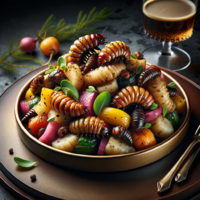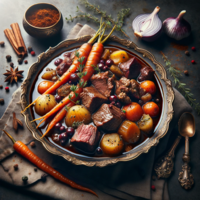Wolgos Cuisine and Cuisine in Hergom
Origins
Wolgos cuisine and palate are profoundly intertwined with their dietary evolution and Neolithic history. As a subspecies with a predatory history, the Wolgos have developed distinct dietary preferences that set them apart from humans. Their culinary choices reflect their past as hunters and raiders of human tribes, as well as their adaptation to a more protein-centric diet. The Wolgos favour a diet that is significantly richer in animal protein compared to humans. They tend to eschew simple carbohydrates like bread, rice, and pasta. Instead, their carbohydrate sources are primarily derived from semi-starchy tubers and vegetables. This dietary shift is a result of their historical reliance on animal and human meat as their primary source of sustenance.
One notable characteristic of Wolgos cuisine is their preference for savoury flavours over sweetness. They often find traditional human cuisine to be overly sweet, as it relies heavily on carbohydrates like bread and potatoes. Refined sugar treats and desserts are generally less appealing to the Wolgos, who instead gravitate towards savoury and nutty treats, occasionally sweetened with honey or natural fruits such as berries.
The Wolgos' prehistory as predators of humans influenced their approach to food preservation and preparation. When raiding human tribes, they often acquired early agricultural produce that had a tendency to spoil over time. To combat this, the Wolgos developed techniques for controlled spoilage and fermentation. Preserving or fermenting meats, in particular, became a popular choice in their cuisine. Another intriguing aspect of Wolgos cuisine is their utilization of arthropods such as maggots and weevils. As the foods they obtained from humans often spoiled during extended periods, they came into contact with arthropods that fed on these spoils. The Wolgos learned to harvest and use these arthropods as a valuable source of protein. These insects not only provided protein but also transformed less desirable carbohydrate-rich spoils into a more desirable protein source.
Present-day Wolgos cuisine is characterized by a preference for bold and intense flavours, including strong sour, acidic, and deep pungent notes. Gamy and robust umami flavors, sourced from various protein-rich ingredients, hold a special place in their culinary repertoire. To balance and complement these strong flavours, the Wolgos often incorporate palate-cleansing and milder elements into their dishes. These include vegetables, cheese, milk curds, and starchy tubers, creating a harmonious blend of taste experiences.
While some human cultures may not fully appreciate Wolgos cuisine due to its unique flavour profile and preferences, others have found it to be intriguing and enjoyable. One notable aspect of Wolgos cuisine is its potential to promote ketosis in humans. The emphasis on protein-rich ingredients and the avoidance of high-carbohydrate foods align with ketogenic metabolic pathways. However, it's worth noting a cautionary point regarding Wolgos breads. Some of their bread varieties may contain ergot, a fungus known for its toxic effects. Humans should exercise caution and avoid consuming Wolgos breads that are exotic and potentially ergot-contaminated.











